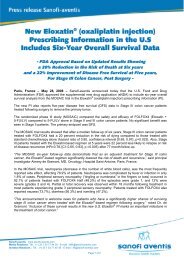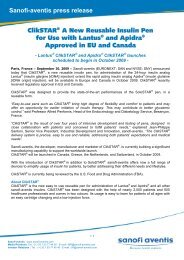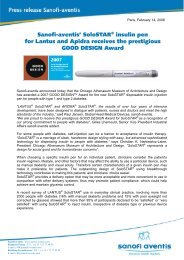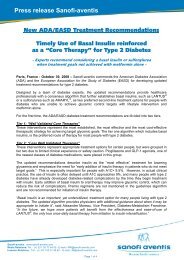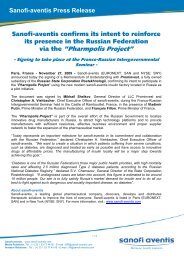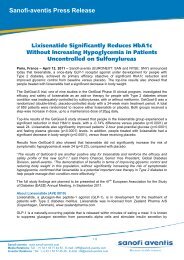European Commission Approved APIDRA® for Treatment of ... - Sanofi
European Commission Approved APIDRA® for Treatment of ... - Sanofi
European Commission Approved APIDRA® for Treatment of ... - Sanofi
Create successful ePaper yourself
Turn your PDF publications into a flip-book with our unique Google optimized e-Paper software.
<strong>European</strong> <strong>Commission</strong> <strong>Approved</strong> APIDRA ®<br />
<strong>for</strong> <strong>Treatment</strong> <strong>of</strong> Children & Adolescents<br />
with Diabetes<br />
Apidra ® (insulin glulisine [rDNA origin] injection),<br />
labelled <strong>for</strong> use shortly be<strong>for</strong>e or soon after meals,<br />
now provides an effective treatment option <strong>for</strong> adults,<br />
adolescents & children (6 years and older) with diabetes<br />
Paris, France - July 24, 2008 - San<strong>of</strong>i-aventis announced today that the <strong>European</strong> <strong>Commission</strong><br />
approved APIDRA ® (insulin glulisine [rDNA origin] injection), a rapid-acting insulin analog, <strong>for</strong> the<br />
control <strong>of</strong> hyperglycemia in adolescents and children (6 years and older) with diabetes mellitus.<br />
The approval <strong>of</strong> APIDRA ® <strong>for</strong> pediatric use provides children (6 years and older) with the option <strong>of</strong><br />
using APIDRA ® as part <strong>of</strong> their overall diabetes treatment plan, usually in combination with a basal<br />
insulin. The approval is based upon review <strong>of</strong> a 26-week, phase III, open-label, active control study <strong>of</strong><br />
APIDRA ® in comparison with Humalog ® (both administered premeal) in 572 children and adolescents<br />
with type 1 diabetes.<br />
APIDRA ® works fast and <strong>of</strong>fers flexible insulin dosing to help manage mealtime blood sugar levels, and<br />
should be administered shortly (0-15 min) be<strong>for</strong>e or soon after the meal. As parents <strong>of</strong>ten need to<br />
administer to their child insulin until he or she is able to administer insulin injections on their own, this<br />
new indication <strong>for</strong> APIDRA ® provides children (6 years and older) and their parents with a new option<br />
<strong>for</strong> treating diabetes, particularly <strong>of</strong> using APIDRA ® SoloSTAR ® to administer APIDRA ® . APIDRA ®<br />
SoloSTAR ® is easy to use and provides pediatric patients and their caregivers with a convenient option<br />
<strong>for</strong> delivering accurate APIDRA ® doses.<br />
“San<strong>of</strong>i-aventis recognizes the many challenges faced by children with diabetes and their families, and<br />
is committed to providing pediatric patients and their healthcare providers with new treatment options,”<br />
said Riccardo Perfetti, MD PhD, Senior Medical Director, Diabetes-Metabolism Franchise, san<strong>of</strong>iaventis.<br />
“Now the rapid-acting insulin analog APIDRA ® will be available to children 6 years and older<br />
with diabetes, and we hope it will <strong>of</strong>fer them an effective treatment <strong>of</strong> choice <strong>for</strong> their overall diabetes<br />
therapy.”<br />
APIDRA ® has a rapid onset and short duration <strong>of</strong> action which allows covering the postprandial<br />
hyperglycemic peaks. It should normally be used in combination with a long-acting or basal insulin to<br />
cover the fasting and interprandial hyperglycemia. APIDRA ® can also be used alone in insulin infusion<br />
pump therapy <strong>for</strong> blood sugar control.<br />
San<strong>of</strong>i-aventis www.san<strong>of</strong>i-aventis.com<br />
Media Relations: Tél. : (+) 33 1 53 77 44 50 - E-mail : MR@san<strong>of</strong>i-aventis.com<br />
Investor Relations : Tél. : (+) 33 1 53 77 45 45 - E-mail : IR@san<strong>of</strong>i-aventis.com<br />
Page 1 <strong>of</strong> 3
About the Study<br />
The approval <strong>of</strong> APIDRA ® <strong>for</strong> pediatric use is based upon a 26-week, phase III, open-label, active<br />
control study <strong>of</strong> APIDRA ® in comparison with Humalog ® , in more than 572 children and adolescents<br />
(4 years and older) with type 1 diabetes.<br />
Study patients received APIDRA ® or Humalog ® 0-15 minutes premeal. These patients received<br />
concomitant treatment with LANTUS ® once daily or NPH twice daily as basal insulin. The majority <strong>of</strong><br />
the patients received Lantus ® as part <strong>of</strong> their basal-prandial regimen (69.7% and 72% in the APIDRA ®<br />
and Humalog ® treated groups, respectively).<br />
The study compared the efficacy <strong>of</strong> APIDRA ® to Humalog ® in terms <strong>of</strong> change in glycohemoglobin<br />
(HbA 1c), which is the amount <strong>of</strong> sugar bound to hemoglobin in the blood. The change in HbA 1c from<br />
baseline to endpoint <strong>for</strong> APIDRA ® and Humalog ® were similar. The mean HbA 1C change in the<br />
APIDRA ® population was +0.10% (± 0.08) and +0.16% (± 0.07) in the Humalog ® group. The difference<br />
between the two treatments <strong>for</strong> this measure was -0.06%, or almost zero, with a 95% confidence<br />
interval <strong>of</strong> (-0.24; 0.12). Postprandial glycemic control, as assessed by the self-monitored blood glucose<br />
values and blood glucose excursions, was similar in both treatment groups at endpoint.<br />
About Type 1 Diabetes<br />
Diabetes is a chronic, widespread condition in which the body does not produce or properly use insulin,<br />
the hormone needed to transport glucose (sugar) from the blood into the cells <strong>of</strong> the body <strong>for</strong> energy. In<br />
patients with type 1 diabetes, the immune system destroys the insulin-producing beta cells <strong>of</strong> the<br />
pancreas that regulate blood glucose. Since the pancreas can no longer produce insulin, people with<br />
type 1 diabetes require daily injections <strong>of</strong> insulin <strong>for</strong> their entire lives.<br />
The International Diabetes Foundation estimates the global number <strong>of</strong> children (14 years <strong>of</strong> age and<br />
younger) with type 1 diabetes to be 440,000, with 70,000 newly diagnosed cases each year.<br />
About LANTUS ® (insulin glargine [rDNA origin])<br />
LANTUS ® is indicated <strong>for</strong> once-daily subcutaneous administration in the treatment <strong>of</strong> adult patients with<br />
type 2 diabetes mellitus who require basal (long-acting) insulin <strong>for</strong> the control <strong>of</strong> hyperglycemia and <strong>for</strong><br />
adult and pediatric patients (6 years and older) with type 1 diabetes mellitus. LANTUS ® demonstrates a<br />
relatively peakless and sustained concentration/time pr<strong>of</strong>ile over 24 hours thus reducing the risk <strong>of</strong><br />
hypoglycemia and allowing a constant and high efficacy over 24h with one single daily injection.<br />
LANTUS ® is the number one prescribed insulin worldwide.<br />
About APIDRA ® (insulin glulisine [rDNA origin])<br />
APIDRA ® is a rapid-acting insulin analog with a unique zinc-free molecular structure that maintains a<br />
rapid onset and a short duration <strong>of</strong> action, indicated <strong>for</strong> adults and now <strong>for</strong> adolescents and children (6<br />
years and older) with diabetes in the EU. APIDRA ® <strong>of</strong>fers patients mealtime dosing flexibility—it can be<br />
taken shortly (0-15 min) be<strong>for</strong>e or soon after the meal. APIDRA ® is also flexible <strong>for</strong> use in a wide range<br />
<strong>of</strong> patients from lean to obese. APIDRA ® is an optimised partner to LANTUS ® once prandial insulin is<br />
required.<br />
About SoloSTAR ®<br />
SoloSTAR ® is a new, easy-to-use disposable pen <strong>for</strong> administration <strong>of</strong> LANTUS ® and APIDRA ® .<br />
SoloSTAR ® allows administering doses from 1 up to 80 units, in one unit increments, in one injection.<br />
SoloSTAR ® <strong>of</strong>fers a 25% greater maximum capacity than other disposable insulin pens, up to 80 units<br />
<strong>of</strong> insulin in one injection. SoloSTAR uses a simple, intuitive design with an easy-to-read display, and<br />
requires only a few steps to use it properly. SoloSTAR ® is small, discreet and eliminates the need <strong>for</strong><br />
the patient to change insulin cartridges. Easy-to-use and easy-to-inject, SoloSTAR ® reduces the<br />
injection <strong>for</strong>ce by 30% or more in comparison to other most broadly available pens in its class. A recent<br />
survey <strong>of</strong> LANTUS ® SoloSTAR ® used in everyday clinical practice, involving more than 2000 people<br />
with diabetes (16% with manual dexterity problems and 15% with poor eyesight not corrected by<br />
glasses) showed that more than 95% <strong>of</strong> participants declared to be “satisfied” or “very satisfied” with<br />
using SoloSTAR ® to inject insulin, irrespective <strong>of</strong> diabetes type or previous device experience.<br />
LANTUS ® SoloSTAR ® and APIDRA ® SoloSTAR ® were approved by the <strong>European</strong> <strong>Commission</strong> in<br />
September 2006; LANTUS ® SoloSTAR ® was approved by the FDA in April 2007. LANTUS ®<br />
Page 2 <strong>of</strong> 3
SoloSTAR ® and APIDRA ® SoloSTAR ® are launched in France, UK, Italy, Spain, Germany, Netherlands,<br />
Slovakia, Slovenia, Sweden, Norway, Iceland, Poland, Austria, Denmark, Estonia, Finland, Greece,<br />
Hungary, Ireland, Latvia, Australia, Lithuania, Lebanon, South Africa, and Switzerland. LANTUS ®<br />
SoloSTAR ® is launched in the US, Canada, Japan and India. The preparation <strong>for</strong> launches in other<br />
countries is planned during 2008.<br />
The Chicago Athenaeum Museum <strong>of</strong> Architecture and Design awarded a 2007 GOOD DESIGN<br />
Award <strong>for</strong> the new SoloSTAR ® disposable insulin injection pen <strong>for</strong> people with type 1 and type 2<br />
diabetes. The Museum’s historic GOOD DESIGN program was founded in Chicago in 1950 by Edgar J.<br />
Kaufmann, Jr. with the participation <strong>of</strong> some <strong>of</strong> America’s most important designers. Every year the jury<br />
meets in New York and select products and graphics worthy <strong>of</strong> the GOOD DESIGN Award <strong>for</strong> design<br />
distinction. GOOD DESIGN remains the oldest and most important Awards program worldwide.<br />
About san<strong>of</strong>i-aventis<br />
San<strong>of</strong>i-aventis, a leading global pharmaceutical company, discovers, develops and distributes therapeutic<br />
solutions to improve the lives <strong>of</strong> everyone. San<strong>of</strong>i-aventis is listed in Paris (EURONEXT : SAN) and in<br />
New York (NYSE : SNY).<br />
Global Media Contact:<br />
Anna Radjanova, MD<br />
Tel: + 33 (0)6 07 28 61 63<br />
E-mail: anna.radjanova@san<strong>of</strong>i-aventis.com<br />
Page 3 <strong>of</strong> 3



